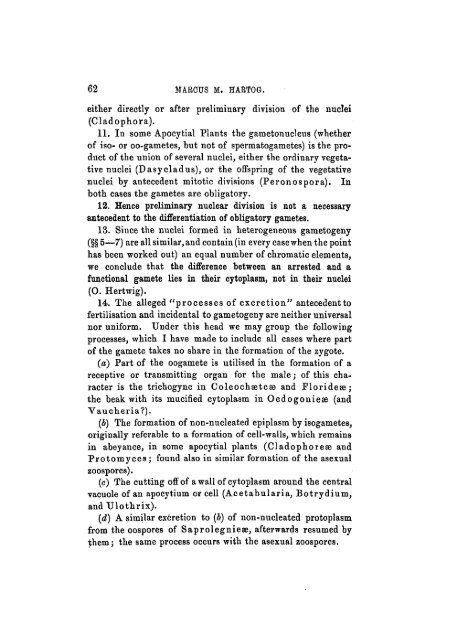Some Problems of Reproduction: a Comparative Study of ...
Some Problems of Reproduction: a Comparative Study of ...
Some Problems of Reproduction: a Comparative Study of ...
Create successful ePaper yourself
Turn your PDF publications into a flip-book with our unique Google optimized e-Paper software.
62 . MARCUS M. HAHTOG.<br />
either directly or after preliminary division <strong>of</strong> the nuclei<br />
(Cladophora).<br />
11. In some Apocytial Plants the gametonucleus (whether<br />
<strong>of</strong> iso- or oo-gametes, but not <strong>of</strong> spermatogametes) is the product<br />
<strong>of</strong> the union <strong>of</strong> several nuclei, either the ordinary vegetative<br />
nuclei (Dasycladus), or the <strong>of</strong>fspring <strong>of</strong> the vegetative<br />
nuclei by antecedent mitotic divisions (Peronospora). In<br />
both cases the gametes are obligatory.<br />
12. Hence preliminary nuclear division is not a necessary<br />
antecedent to the differentiation <strong>of</strong> obligatory gametes.<br />
13. Since the nuclei formed in heterogeneous gametogeny<br />
(§§ 5—7) are all similar, and contain (in every case when the point<br />
has been worked out) an equal number <strong>of</strong> chromatic elements,<br />
we conclude that the difference between an arrested and a<br />
functional gamete lies in their cytoplasm, not in their nuclei<br />
(0. Hertwig).<br />
14. The alleged "processes <strong>of</strong> excretion" antecedent to<br />
fertilisation and incidental to gametogeny are neither universal<br />
nor uniform. Under this head we may group the following<br />
processes, which I have made to include all cases where part<br />
<strong>of</strong> the gamete takes no share in the formation <strong>of</strong> the zygote.<br />
(a) Part <strong>of</strong> the oogamete is utilised in the formation <strong>of</strong> a<br />
receptive or transmitting organ for the male; <strong>of</strong> this character<br />
is the trichogyne in Coleochseteaa and Floridese;<br />
the beak with its mucified cytoplasm in Oedogoniese (and<br />
Vaucheria?).<br />
(b) The formation <strong>of</strong> non-nucleated epiplasm by isogametes,<br />
originally referable to a formation <strong>of</strong> cell-walls, which remains<br />
in abeyance, in some apocytial plants (Cladophoreae and<br />
Protomyces ; found also in similar formation <strong>of</strong> the asexual<br />
zoospores).<br />
(c) The cutting <strong>of</strong>f <strong>of</strong> a wall <strong>of</strong> cytoplasm around the central<br />
vacuole <strong>of</strong> an apocytium or cell (Acetabularia, Botrydium,<br />
and Ulothrix).<br />
(d) A similar excretion to (b) <strong>of</strong> non-nucleated protoplasm<br />
from the oospores <strong>of</strong> Saprolegniese, afterwards resumed by<br />
them; the same process occurs with the asexual zoospores.

















